NVIDIA GeForce GTX 780 Review: The New High End
by Ryan Smith on May 23, 2013 9:00 AM ESTPower, Temperature, & Noise
As always, last but not least is our look at power, temperature, and noise. Next to price and performance of course, these are some of the most important aspects of a GPU, due in large part to the impact of noise. All things considered, a loud card is undesirable unless there’s a sufficiently good reason – or sufficiently good performance – to ignore the noise.
GTX 780 comes into this phase of our testing with a very distinct advantage. Being based on an already exceptionally solid card in the GTX Titan, it’s guaranteed to do at least as well as Titan here. At the same time because its practical power consumption is going to be a bit lower due to the fewer enabled SMXes and fewer RAM chips, it can be said that it has Titan’s cooler and a lower yet TDP, which can be a silent (but deadly) combination.
| GeForce GTX 780 Voltages | ||||
| GTX 780 Max Boost | GTX 780 Base | GTX 780 Idle | ||
| 1.1625v | 1.025v | 0.875v | ||
Unsurprisingly, voltages are unchanged from Titan. GK110’s max safe load voltage is 1.1625v, with 1.2v being the maximum overvoltage allowed by NVIDIA. Meanwhile idle remains at 0.875v, and as we’ll see idle power consumption is equal too.
Meanwhile we also took the liberty of capturing the average clockspeeds of the GTX 780 in all of the games in our benchmark suite. In short, although the GTX 780 has a higher base clock than Titan (863MHz versus 837MHz), the fact that it only goes to one higher boost bin (1006MHz versus 993MHz) means that the GTX 780 doesn’t usually clock much higher than GTX Titan under load; for one reason or another it typically settles at the boost bin as the GTX Titan on tests that offer consistent work loads. This means that in practice the GTX 780 is closer to a straight-up harvested GTX Titan, with no practical clockspeed differences.
| GeForce GTX Titan Average Clockspeeds | ||||
| GTX 780 | GTX Titan | |||
| Max Boost Clock | 1006MHz | 992MHz | ||
| DiRT:S |
1006MHz
|
992MHz | ||
| Shogun 2 |
966MHz
|
966MHz | ||
| Hitman |
992MHz
|
992MHz | ||
| Sleeping Dogs |
969MHz
|
966MHz | ||
| Crysis |
992MHz
|
992MHz | ||
| Far Cry 3 |
979MHz
|
979MHz | ||
| Battlefield 3 |
992MHz
|
992MHz | ||
| Civilization V |
1006MHz
|
979MHz | ||
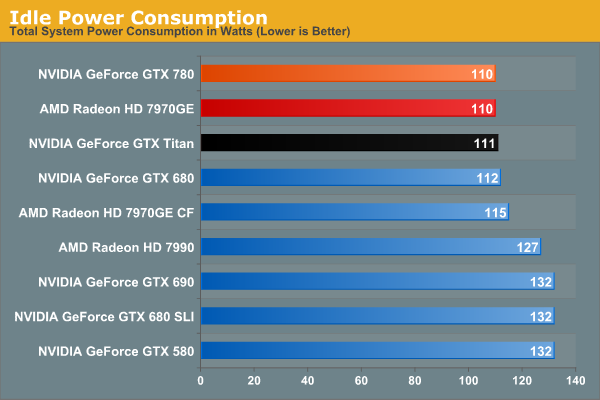
Idle power consumption is by the book. With the GTX 780 equipped, our test system sees 110W at the wall, a mere 1W difference from GTX Titan, and tied with the 7970GE. Idle power consumption of video cards is getting low enough that there’s not a great deal of difference between the latest generation cards, and what’s left is essentially lost as noise.
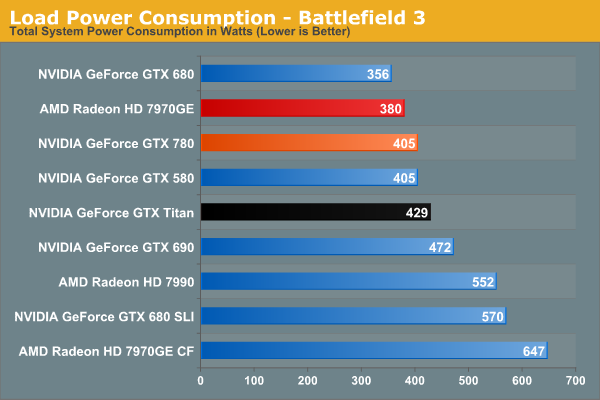
Moving on to power consumption under Battlefield 3, we get our first real confirmation of our earlier theories on power consumption. Between the slightly lower load placed on the CPU from the lower framerate, and the lower power consumption of the card itself, GTX 780 draws 24W less at the wall. Interestingly this is exactly how much our system draws with the GTX 580 too, which accounting for lower CPU power consumption means that video card power consumption on the GTX 780 is down compared to the GTX 580. GTX 780 being a harvested part helps a bit with that, but it still means we’re looking at quite the boost in performance relative to the GTX 580 for a simultaneous decrease in video card power consumption.
Moving along, we see that power consumption at the wall is higher than both the GTX 680 and 7970GE. The former is self-explanatory: the GTX 780 features a bigger GPU and more RAM, but is made on the same 28nm process as the GTX 680. So for a tangible performance improvement within the same generation, there’s nowhere for power consumption to go but up. Meanwhile as compared to the 7970GE, we are likely seeing a combination of CPU power consumption differences and at least some difference in video card power consumption, though this doesn’t make it possible to specify how much of each.
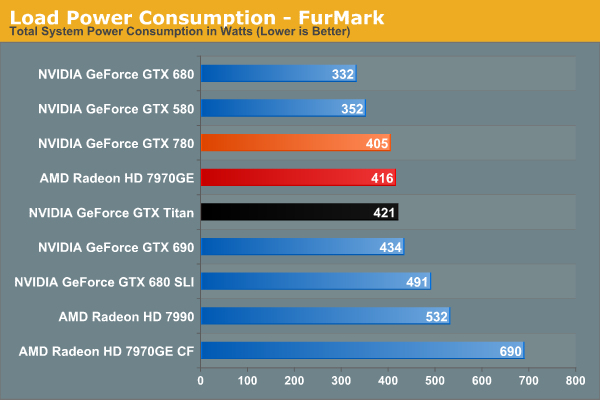
Switching to FurMark and its more pure GPU load, our results become compressed somewhat as the GTX 780 moves slightly ahead of the 7970GE. Power consumption relative to Titan is lower than what we expected it to be considering both cards are hitting their TDP limits, though compared to GTX 680 it’s roughly where it should be. At the same time this reflects a somewhat unexpected advantage for NVIDIA; despite the fact that GK110 is a bigger and logically more power hungry GPU than AMD’s Tahiti, the power consumption of the resulting cards isn’t all that different. Somehow NVIDIA has a slight efficiency advantage here.
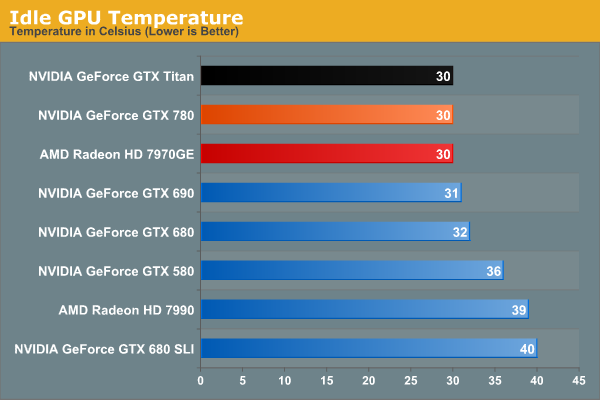
Moving on to idle temperatures, we see that GTX 780 hits the same 30C mark as GTX Titan and 7970GE.
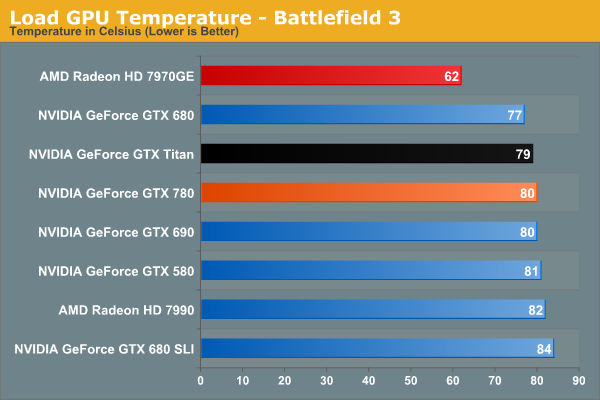
With GPU Boost 2.0, load temperatures are kept tightly in check when gaming. The GTX 780’s default throttle point is 80C, and that’s exactly what happens here, with GTX 780 bouncing around that number while shifting between its two highest boost bins. Note that like Titan however this means it’s quite a bit warmer than the open air cooled 7970GE, so it will be interesting to see if semi-custom GTX 780 cards change this picture at all.
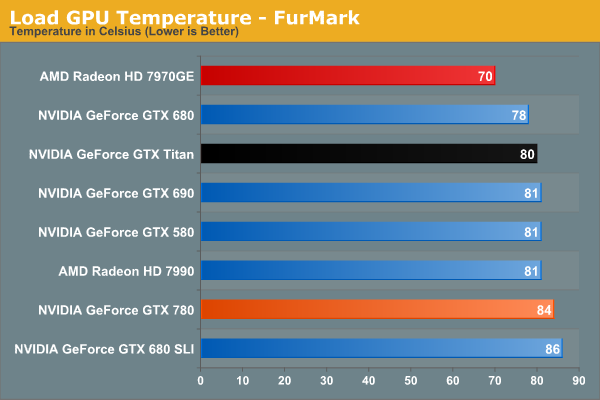
Whereas GPU Boost 2.0 keeps a lid on things when gaming, it’s apparently a bit more flexible on FurMark, likely because the video card is already heavily TDP throttled.
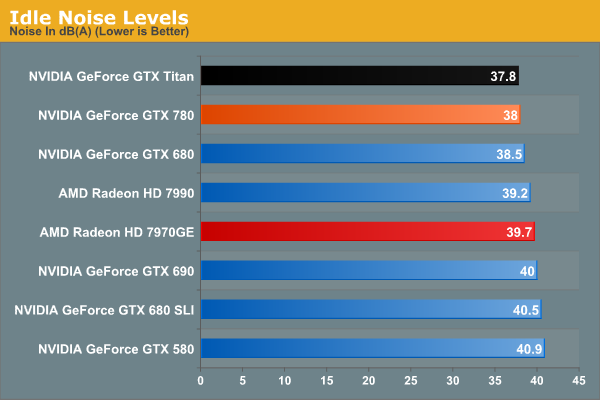
Last but not least we have our look at idle noise. At 38dB GTX 780 is essentially tied with GTX Titan, which again comes at no great surprise. At least in our testing environment one would be hard pressed to tell the difference between GTX 680, GTX 780, and GTX Titan at idle. They’re essentially as quiet as a card can get without being silent.
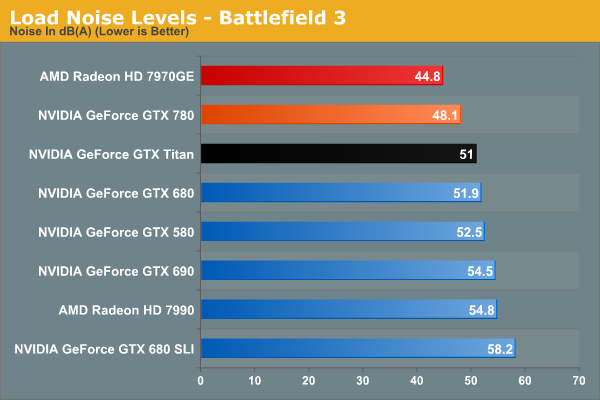
Under BF3 we see the payoff of NVIDIA’s fan modifications, along with the slightly lower effective TDP of GTX 780. Despite – or rather because – it was built on the same platform as GTX Titan, there’s nowhere for idle noise to go down. As a result we have a 250W blower based card hitting 48.1dB under load, which is simply unheard of. At nearly a 4dB improvement over both GTX 680 and GTX 690 it’s a small but significant improvement over NVIDIA’s previous generation cards, and even Titan has the right to be embarrassed. Silent it is not, but this is incredibly impressive for a blower. The only way to beat something like this is with an open air card, as evidenced by the 7970GE, though that does comes with the usual tradeoffs for using such a cooler.
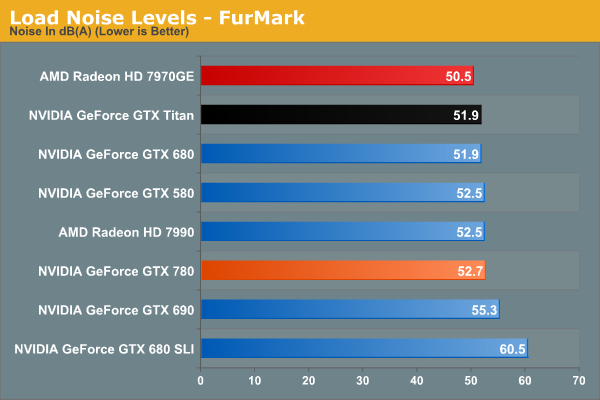
Because of the slightly elevated FurMark temperatures we saw previously, GTX 780 ends up being a bit louder than GTX Titan under FurMark. This isn’t something that we expect to see under any non-pathological workload, and I tend to favor BF3 over FurMark here anyhow, but it does point to there being some kind of minor difference in throttling mechanisms between the two cards. At the same time this means that GTX 780 is still a bit louder than our open air cooled 7970GE, though not by as large a difference as we saw with BF3.
Overall the GTX 780 generally meets or exceeds the GTX Titan in our power, temp, and noise tests, just as we’d expect for a card almost identical to Titan itself. The end result is that it maintains every bit of Titan’s luxury and stellar performance, and if anything improves on it slightly when we’re talking about the all-important aspects of load noise. It’s a shame that coolers such as 780’s are not a common fixture on cheaper cards, as this is essentially unparalleled as far as blower based coolers are concerned.
At the same time this sets up an interesting challenge for NVIDIA’s partners. To pass Greenlight they need to produce cards with coolers that function as good or as better than the reference GTX 780 in NVIDIA’s test environment. This is by no means impossible, but it’s not going to be an easy task. So it will be interesting to see what partners cook up, especially with the obligatory dual fan open air cooled models.










155 Comments
View All Comments
Stuka87 - Thursday, May 23, 2013 - link
The video card does handle the decoding and rendering for the video. Anand has done several tests over the years comparing their video quality. There are definite differences between AMD/nVidia/Intel.JDG1980 - Thursday, May 23, 2013 - link
Yes, the signal is digital, but the drivers often have a bunch of post-processing options which can be applied to the video: deinterlacing, noise reduction, edge enhancement, etc.Both AMD and NVIDIA have some advantages over the other in this area. Either is a decent choice for a HTPC. Of course, no one in their right mind would use a card as power-hungry and expensive as a GTX 780 for a HTPC.
In the case of interlaced content, either the PC or the display device *has* to apply post-processing or else it will look like crap. The rest of the stuff is, IMO, best left turned off unless you are working with really subpar source material.
Dribble - Thursday, May 23, 2013 - link
To both of you above, on DVD yes, not on bluray - there is no interlacing, noise or edges to reduce - bluray decodes to a perfect 1080p picture which you send straight to the TV.All the video card has to do is decode it, which why a $20 bluray player with $5 cable will give you exactly the same picture and sound quality as a $1000 bluray player with $300 cable - as long as TV can take the 1080p input and hifi can handle the HD audio signal.
JDG1980 - Thursday, May 23, 2013 - link
You can do any kind of post-processing you want on a signal, whether it comes from DVD, Blu-Ray, or anything else. A Blu-Ray is less likely to get subjective quality improvements from noise reduction, edge enhancement, etc., but you can still apply these processes in the video driver if you want to.The video quality of Blu-Ray is very good, but not "perfect". Like all modern video formats, it uses lossy encoding. A maximum bit rate of 40 Mbps makes artifacts far less common than with DVDs, but they can still happen in a fast-motion scene - especially if the encoders were trying to fit a lot of content on a single layer disc.
Most Blu-Ray content is progressive scan at film rates (1080p23.976) but interlaced 1080i is a legal Blu-Ray resolution. I believe some variants of the "Planet Earth" box set use it. So Blu-Ray playback devices still need to know how to deinterlace (assuming they're not going to delegate that task to the display).
Dribble - Thursday, May 23, 2013 - link
I admit it's possible to post process but you wouldn't, a real time post process is highly unlikely to add anything good to the picture - fancy bluray players don't post process, they just pass on the signal. As for 1080i that's a very unusual case for bluray, but as it's just the standard HD TV resolution again pass it to the TV - it'll de-interlace it just like it does all the 1080i coming from your cable/satelight box.Galidou - Sunday, May 26, 2013 - link
''All the video card has to do is decode it, which why a $20 bluray player with $5 cable will give you exactly the same picture and sound quality as a $1000 bluray player with $300 cable - as long as TV can take the 1080p input and hifi can handle the HD audio signal.''I'm an audiophile and a professionnal when it comes to hi-end home theater, I myself built tons of HT system around PCs and or receivers and I have to admit this is the funniest crap I've had to read. I'd just like to know how many blu-ray players you've personnally compared up to let's say the OPPO BDP -105(I've dealt with pricier units than this mere 1200$ but still awesome Blu-ray player).
While I can certainly say that image quality not affected by much, the audio on the other side sees DRASTIC improvements. Hardware not having an effect on sound would be like saying: there's no difference between a 200$ and a 5000$ integrated amplifier/receiver, pure non sense.
''the same picture and sound quality''
The part speaking about sound quality should really be removed from your comment as it really astound me to think you can beleive what you said is true.
eddman - Thursday, May 23, 2013 - link
http://i.imgur.com/d7oOj7d.jpgEzioAs - Thursday, May 23, 2013 - link
If I were a Titan owner (and I actually purchase the card, not some free giveaway or something), I would regret that purchase very, very badly. $650 is still a very high price for the normal GTX x80 cards but it makes the Titan basically a product with incredibly bad pricing (not that we don't know that already). Still, I'm no Titan owner, so what do I know...On the other hand, when I look at the graphs, I think the HD7970 is an even better card than ever despite it being 1.5 years older. However, as Ryan pointed out for previous GTX500 users who plan on sticking with Nvidia and are considering high end cards like this, it may not be a bad card at all since there are situations (most of the time) where the performance improvements are about twice the GTX580.
JeffFlanagan - Thursday, May 23, 2013 - link
I think $350 is almost pocket-change to someone who will drop $1000 on a video card. $1K is way out of line with what high-quality consumer video cards go for in recent years, so you have to be someone who spends to say they spent, or someone mining one of the bitcoin alternatives in which case getting the card months earlier is a big benefit.mlambert890 - Thursday, May 23, 2013 - link
I have 3 Titans and don't regret them at all. While I wouldn't say $350 is "pocket change" (or in this case $1050 since its x3), it also is a price Im willing to pay for twice the VRAM and more perf. With performance at this level "close" doesn't count honestly if you are looking for the *highest* performance possible. Gaming in 3D surround even 3xTitan actually *still* isn't fast enough, so no way I'd have been happy with 3x780s for $1000 less.